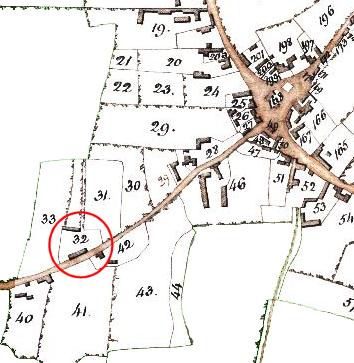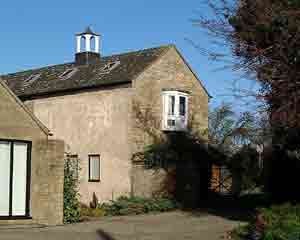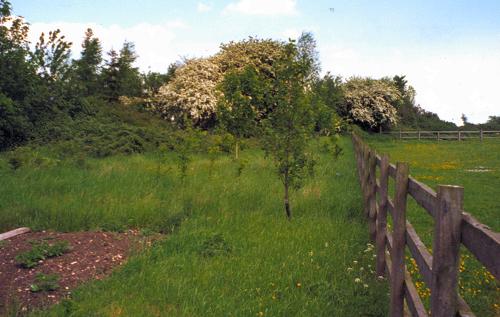
The 1600's were a period in which Nonconformism emerged and, despite efforts by the Church authorities to suppress it, the number of dissenters increased. Sherington was no exception to this and Richard Hunt, who was a local ploughwright, was one of those persecuted for his beliefs, as the Meetings of the local Friends were held in his house in Water Lane. Further details of the dissent in this period, including extracts from the Episcopal Visitation books, are given below.
In 1689, when the Act of Toleration was passed, the Meeting House was formally registered. The home close was used as a burial ground. In 1712, 17 of the 110 families in the village were Quakers.
The 'Quaker Society Meeting House and Garden' is marked on the 1796 Enclosure Map as Plot 32 (see right). This location is now 38/40 Water Lane.
On the 1796 map, there are two buildings on Plot 32. The one immediately adjacent to Water Lane has not survived. Comparison of the 1796 map and current aerial photographs (e.g. GoogleMaps or Microsoft Virtual Earth) indicates that one section of the current building (that part with the interesting structure on the roof, shown in the photo below) is in the same location as the one on the map, suggesting that it may be the same building.
According to Chibnall's book, the property was one of the old-established cottages in the village, and that the Court Rolls for the Linford Manor/Tyringham estate showed that a small quit-rent of 1d. was payable on it. The book states that in 1708 the owner of the property was Ann Marshall.

Extract from 'An Inventory of Non Conformist Chapels and Meeting-houses in Central England'
Royal Commission on the Historical Monuments of England. Buckinghamshire, 1986
(77) Former Friends, Water Lane (SP885464)
A meeting in existence by 1662 was supported by Richard Hunt, a ploughwright, and met on his premises in Water Lane which were registered in 1689. Meetings ceased by the late 18th century and the meeting house was reported to have been converted into three cottages. A long narrow building of stone with a slate roof, 15ft by 52ft externally, formerly three cottages but now forming part of Nos. 38 and 40 Water Lane may represent the former meeting house; it has no datable features.
Changes in the Friends Meetings 1784-1865
Sherington Monthly Meeting united with Hogsty End MM in 1784. (At that time Hogsty End was part of Wavendon parish and only in the 1800's did the area become known as Woburn Sands). This in turn united with Buckingham Monthly Meeting to form Leighton Monthly Meeting in 1822. In 1857, Leighton joined with Upperside (previously known as Hunger Hill) and then with Luton in 1865, to form Luton and Leighton Monthly Meeting.
Parish Registers
Buckinghamshire County Council's Centre for Bucks Studies, Aylesbury, has a number of local Quaker registers on microfilm in its Non-conformist parish registers collection. According to its website, the following registers are available for the Sherington Monthly Quaker (Society of Friends) Meeting: marriages 1658-1697, births 1645-1774 and 1777-1793, burials 1687-1766 and 1777-1805.
Information from ' Sherington - Fiefs and Fields of a Buckinghamshire Village'
by A C Chibnall, 1965, Chapter 26 'The Emergence of Non-conformity'1633-6
Twenty people, including eleven women, were presented at the ecclesiastical court for attending meetings in Newport Pagnell and Olney on Sundays, instead of going to their own parish church.
1 August 1633
The archeacon appointed a commission of prominent local people to deal with the problem of dissent in Sherington. The commission consisted of Thomas Gilder (the Rector), Anthony Tyringham, William Norton, Thomas Lowe, John Chibnall, Edward and Robert Wallis and Thomas Knight. The three leaders Anthony Newall, Richard Hooton and Robert White were excommunicated and others were allotted special seats in church during services.
January 1634
Mary Newall (wife of Thomas), Alice Hooton (wife of Richard) and Goodwife Field were presented for refusing to sit in the allotted seats.
4 November 1636
"Alice Feild the wife of Richard Feild presented for breaking a seate in the Church wherein she was appointed to sit."
Easter 1637
A conventicle was held in Sherington at Michael Baker's home (Plot 54 on the 1796 Enclosure map). "...present that we have heard there was a repeticon of Mr Seatons sermon (which he preached in the parish aforesaid) in one Michael Baker's house but by whom the repeticon was made we know not nor who was present there".
1637-8
Anthony Newall and Philip Kirtland (with wife Rose and eldest son John) and others from Newport and Olney emigrated to Lynn, New England. Philip's younger sons, Philip and Nathaniel, had already emigrated in 1635. Philip Kirtland was the tenant of the Mercers' Company's Manor Farm, for which they had bought the copyhold for £300 on 17 November 1620 from William Fisher, the annual rent being 50s. 2d. Another emigrant, John Fuller from Olney, was the brother of Ignatius Fuller who was appointed Rector of Sherington in 1647.
1649
John Cunningham, farmer and butcher and a follower of George Fox, refuses to make his tithe payment to the new Rector and was encouraging others to do likewise. He claimed "there is noe manner of tithe due to the rector or any other minister of religion or parson whatever".
Hilary Term 1653
Ignatius Fuller opens proceedings in the court of exchequer against Thomas Lowe and eighteen farmers for withholding tithe to the total of £144 relating to more than half the arable and pasture land of the village.
1662-5
The rector's tithe suits and presentments at the archeadon's courts in this period indicate that the number of dissenters was in excess of 50, with at least 14 unbaptised children in 34 families. This represented more than a third of the entire village.
1662-1670
Richard Hunt, whose home became the quakers' meeting house, is sent to gaol several times by the local justices, including Brett Norton and Anthony Chester, for absenting himself from church.
6 April 1670
Richard Hunt "for preaching Truth in a meeting of Friends in the open street called Water Lane, at Sherington (being kept out of their Meeting house) on the 6th day of the fourth month, 1670, was fined ten pounds by Brett Norton and Thomas Farrer of Cold Brayfield, for which fine, on the fourteenth day of the said month the said Richard Hunt, being a Wheelwright, had a new cart and as much timber as was, with the cart, worth £12 14s. taken from him by Thomas Clifton and John Philip, Constables and Thomas Marshall, John Babbington and John Field, Overseers of the Poor".
1672
Archbishop Sheldon was trying to stifle dissent and at the Easter sessions in Aylesbury there was an order that "the Lawes against Dissenters from Church be recommended to all the Justices of the Peace within this County to be putt into execution". In the following three years, 44 people were presented at the assizes and some of these, plus six others, at the archdeacon's court. Over 40 families were involved.
30 March 1677
At a meeting at Mr Elwood's the sum of £19 16s. 11d. was brought in from ten other meetings in Buckinghamshire to help those who had lately suffered by fire at Sherington. The money was sent to Stephen Marshall.
1683
Richard Marks, a leading Quaker, was sued by Ignatius Fuller in the ecclesiastical court and sent to Aylesbury gaol, where he remained for ten months, during which time a fourth part of his corn was seized. However, "his Neighbours, not knowing what to do well without (he being the chief Smith in the Town) satisfied the greedy Priest and fetched Thomas home from Prison".
1683
The Quakers conventicle in 1683 resulted in a heavy fine from Owen Norton, who had followed his father Brett as a Justice of the Peace.
Chibnall quotes various sources for this information, including the Buckinghamshire Archdeaconry Visitation Books, the Mercers' Company Court of Assistants Minute Books, Buckinghamshire Archaeology Society Records Branch, Buckinghamshire Record Society, Exchequer Queen's Remembrancer Bills and Answers, F W Bull's 'History of Newport Pagnell' (1900), V C Sanbarn 'New England Hist. and General Reg. XLVIII' (1894) and Hotton 'Emigrants to America , 1600-1700'.
Extract from 'Episcopal Visitation Book for the Archdeaconry of Buckinghamshire 1662'
edited by ERC Brinkworth, Vol 7 Bucks Record SocietyRobert Sanderson July 1662
See of Lincoln in 1660
Sherington
John Field, Hugh Smith presentant we have severall children in our parishe unbaptized whose names we shall give you in within convenient tyme by you limited; we have no surpliss, no book of Common Prayer nor book of homilies, but shall provide them as soon as possibly we can.
We have severall in our parishe who do not repaire to divine service, whose names we shall give you in convenient tyme as before. Richard Hunt and Susan Goodin do live together as man and wife and we suppose was never lawfully married.
25 Sept; 62; qu., v.m. in prox 22 Oct. 62: apparitor certificavit esse in carcere apud Alesburie
12 Nov. 63: c., pco., non comp., emt. 12 Nov. 63 nomine vicarii generalis.
dict. Susanna presentatus ut supra.
25 Sept 62: c., non comp., ex. emt. ut supra
Extract from 'Buckinghamshire Dissent and Parish Life 1669-1712'
Edited by John Broad, Buckinghamshire Record Society No 28 1993Robert Sanderson July 1662
See of Lincoln in 1660
Answers to Archbishop Sheldon's Questions by the Clergy concering Non-conformists, 1669
(response to instructions from Archbishop of Canterbury, Gilbert Sheldon - by Bishop of Lincoln: William Fuller)
To the first: wee have one conventicle of Quakers. They meett at the house of Richard Hunt and have done soe these 7 yeares.
To the second: theire number is 20 or 30, and of late have increased.
To the third: they are of mean condition, the names of the cheife are Richard Hunt, ploughwright, Thomas Harman, butcher, Thomas Hootton, John Fensham and Stephen Marshall.
To the fourth: wee suppose they teach one another.
To 5,6: we know noe authority they pretend.
To 7: the same persons doe meett at several conventicles.
To 8: wee doubt not but they might easily be suppressed by the help of the civill magistrate.
Ignatius Fuller, Rector ididem.
Bishop Wake's Summary of the Response to his Visitation Questionnaires from Buckingham Archdeaconery 1706-12
Visitation AD 1706
(a) Mr Ignatius Fuller, Rector
The Bishop of Lincoln, Patron
(b) It is a large place and has about 120 families. Here are a great many Presbyterians, and Quakers, which last have a meeting house in the parish. The Rectory is worth £150 per annum.
(c) There is no lecture, school, almes-house, or hospital in this parish.
No person of quality or gentleman of estate lives, or has any seat in it.
No monuments of note in the church, but a legacie of £50 is let by Mr Edward Fuller who lies buryed here, for a monument to be erected in the chancell who has also left £5 for ever to payd annually for an anniversary sermon upon the 27th of March
Visitation AD 1712
Mr John Barton, Rector
Institution December 20 1711
Families 110, of which 31 dissenters
Independents and Anabaptists besides 17 of Quakers
The last have not only a meeting house, but a burying place here. They meet every other Sunday and on the first Wednesday of the month, from all parts round about.
Lands given to the repair of the church to the value of 13 shillings 4 pence per year.
To the poor £5 a year by Mr Edward Fuller. Vizt.
For a sermon March 27 to the Rector, 20 shillings
To the churchwardens for a dinner, 10 shillings
To the clerk 5 shillings
To the poor 26 halfe crowns, for such only as come to church.
This is duly payd, but the Executors refuse to settle it according to the will.
Also 12 penny loaves distributed to the poor every Sunday, the person giving it now living in the parish
Some come to church unbaptized; many not confirmed.
Two Anabaptist's children lately baptized.
Divine Service twice every Lord's Day. Also Holy-days and Litany days.
Catechizing every Wednesday and Friday.
Communions 4 times a year; but 12 received at Easter last. Notice duly given.
No pennances nor commutation since my Visitation.
Quaker Burial Ground
The Burial Ground was situated next to the Meeting House.

Quaker Register of Births 1777-1793
| Date | Name | Parent's Names | Birthplace | Piece | Fol | |
| 7 Apr 1777 | Baringer | Elizabeth | Thomas & Martha | Ravenstone | RG6/90 | 2 |
| 9 Apr 1792 | Day | John | John & Mary | Hide Farm Olney | RG6/90 | 4 |
| 12 Dec 1793 | Day | Mary | John & Mary | Hide Farm Olney | RG6/90 | 5 |
| 21 Aug 1787 | Richardson | Mary | William & Mary | Cold Brayfield | RG6/90 | 3 |